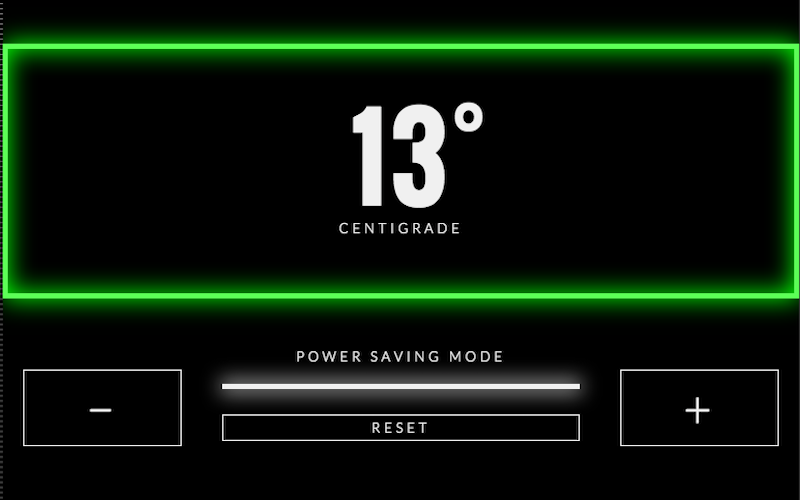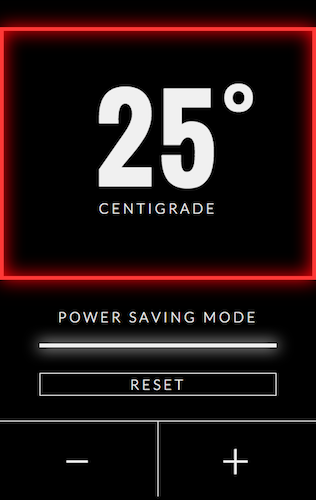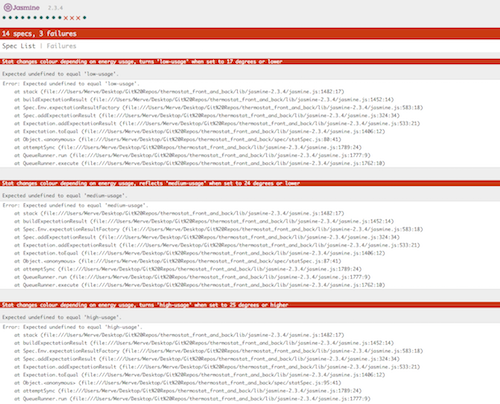This Thermostat App was built from scratch and shows I have a good understanding of Back End code, and how specifically JavaScript can be used for more than just Front End projects.
Thermostatic's back is built in pure JavaScript, and is Unit Tested using the Jasmine test suite. Added to this the App includes jQuery for the interface and a Meyer-reset for the CSS.
The Specifications were as follows:
- Thermostat must start at 20 degrees
- You can increase the temperature with the up button
- You can decrease the temperature with the down button
- The minimum temperature is 10 degrees
- The maximum temperature is 32 degrees
- Power saving mode is on by default
- If power saving mode is on, the maximum temperature is 25 degrees
- If power saving mode is off, the maximum temperature is 32 degrees
- You can reset the temperature to 20 by hitting the reset button
- The thermostat should color the display based on energy usage - < 18 is green, < 25 is yellow, otherwise red
| Desktop View | Mobile View |
|---|---|
 |
 |
Despite the bad pun, it was very fun to build something entirely from scratch and use JavaScript in a format that I'm not as used to. I have used Jasmine as a testing suite for my apps in the past but became much more familiar with it thanks to this project.
As an extra level of difficulty, I asked for a design spec from a friend rather than build something random from my own imagination. Building to web designers specifications is a crucial part of being a Front End developer and I wanted to see what challenges it could possibly raise in a working environment.
- CSS
- HTML
- JavaScript
- jQuery
- Jasmine
- Meyer-Reset
Re-familiarising myself with JavaScript as a Back End language was challenging if only for the syntax, but overall it was a pleasent experience and I gained much from doing so.
Using the Jasmine testing suite meant bugs were much easier to catch and fix then they would have been otherwise, and my code became a lot cleaner as a result. But it did mean that every time I altered the code slightly, or even logically, Jasmine would display what seemed like a world ending break error message about my code!. So it would on first appearance, seem to have gone from 1 bug, to 100!
Luckily once one is familiar with these Jasmine errors, the syntax and the way it 'works', these messages are less intimidating, and more useful.
Originally I used absolute positioning to create the designs but found that I had used it incorrectly much to my displeasure, and had to start again, twice over...it did mean I got to learn about z-index in more detail though. In the end I did use absolute positioning after all, but not in the way I had originally expected.
vh and vw were new measurement tools I had not applied before and they solved a lot of the sizing issues I had when it came to making the layouts responsive.
Getting the jQuery to change the colour display dependent on the temperature setting presented a challenge I could not over come, but after having my code reviewed it turned out to be 'code blindness' rather than any drastic errors on my part. This was both a relief and incredibly frustrating as always.
🎼 99 JavaScript Bugs in my code!... ♬ ♪
🎼 99 JavaScript Bugs!... ♪
🎼 𝄫 You take one down! ♩
🎼 𝄫 You patch it around! ♩
🎼 1570342 JavaScript Bugs in my code!... ♬ ♪
